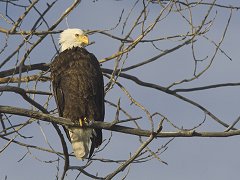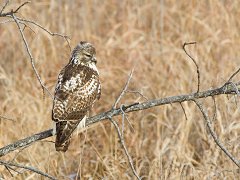|
Squaw Creek National Wildlife Refuge
Northwest Missouri Eagles, Nov. 30-Dec. 3, 2005
[Photos] [2006 Report]

Eagle in Missouri |
During my work assignment in Kansas City earlier this year, I made the 90-mile drive to Squaw Creek National Wildlife Refuge in northwest Missouri in April, May and July. To my surprise I found that Squaw Creek was a place to find a concentration of bald eagles during the winter. My KC exile ended in August but I resolved to return in early December and check out the eagle action.
After arrival Wednesday, Nov. 30, I was able to squeeze in a half day at the refuge and came up with a count of 35 eagles, five hawks, and thousands of snow geese and other waterfowl. The number of eagles perceptibly increased during the short four days I was there. Through the binoculars on Saturday, Dec. 3, I was able to see 72 eagles from the shore of the appropriately-named Eagle Pool, and I knew there were a few dozen more scattered around that I could not see from that spot. I picked up a copy of the Friends of Squaw Creek newsletter and found out that the peak for eagles in 2004 was on Dec. 22 with 391 birds. If I had known that I might have delayed my trip by a week or so.
On the other hand, if I had done that I might have missed the snow geese. The newsletter says the peak waterfowl numbers in 2004 were on Nov. 18 with 128,000 ducks and 320,000 snow geese, with most of them gone by the end of December. Although this year the refuge is reporting fewer waterfowl, there were still an estimated 50,000 ducks and 50,000 snow geese on hand when I arrived. It is an impressive sight and sound as thousands of geese take to the air at once, circle around, then settle down again in a new spot. (Or back in the same spot. What's the point?)

Snow geese take off |
Squaw Creek National Wildlife Refuge is a few miles from where Missouri, Nebraska and Kansas come together at the Missouri River. The refuge visitor's center is on US 159, three miles southwest of I-29 Exit 79. The 10-mile Wild Goose loop starts near the visitor's center, and the Mallard Marsh Road is the only other publicly accessible road. Going clockwise on the one-way loop road, the Mallard Marsh Road splits off about one-third of the way around and leads to state road 118 and Mound City. There is one pair of eagles resident on the refuge, and during the summer I saw them in their nest just after the turnoff onto Mallard Marsh Road. It was hard to see into the nest through the leaves, but I detected some movement back then that I choose to believe was the eagle chick. A few months later I saw the fledgling a few trees away from the nest. On my recent trip, I did the loop several times a day and usually drove at least part of the Mallard Marsh Road. I started to recognize where a particular juvenile eagle preferred to roost. It was not far from the nest, and I wondered if it was the local fledgling. I also started to recognize where the local hawks often roosted. And of course I was able to get a few snapshots with my 300mm lens and 1.4x extender. Red-tailed hawks are the only hawks listed as "common" in the refuge bird list, so I'm assuming all of the hawks were red tails. The red tail is not evident in all the photos, but one of my bird books says not all red-tails have red tails. If anyone has a better ID I would be happy to change the descriptions.
On Saturday as I made the turn at the northwest corner of the loop where the ponds give way to fieIds and forest, I was wondering where the alleged 800 deer were since I hadn't seen any yet. On cue a young buck ran across the road, stopping to pose for a portrait. I saw a couple more deer later near the same location.
Thursday was the best day for sunlight and blue sky. The other three days the light was filtering through the clouds. It wasn't a heavy overcast so some of the images from those days aren't too bad. It was cold enough to turn much of the ponds' surface to ice, although there was enough open water for the ducks and geese to swim around.
Unlike what I have seen along the Mississippi River where the eagles were fishing, at Squaw Creek there was no fishing in the shallow, partially-frozen pools. As a result there was very little traffic overhead and few opportunities for in-flight images. The eagles lurked around the edges of the geese and duck flocks, roosting in trees, sitting on muskrat lodges, or just standing on the ice. They were looking to pick off the weak, and I saw two eagles retreat to the trees with their prizes. Through binoculars I could see them ripping apart what appeared to be ducks. Although there was no fishing action in the ponds, a few miles west at the deeper Big Lake, I saw an eagle up in a tree with a very large fish. (There also was a pair of red-tailed hawks lurking nearby, hoping to share.) As the eagle numbers increase through December, Big Lake State Park might be a place to see some fishing action.

Hawk |
When I saw the 25-foot rubber eagle being inflated next to the visitor's center on Thursday, I decided that perhaps it would be a good idea not to stick around for the entirety of Eagle Days that weekend. There were a lot of school kids going through the refuge on buses Friday, and Saturday there were dozens of cars parked at the visitor's center as the general public boarded buses for tours. I prefer my wildlife refuges to be empty of people, so I concluded my activities at 11 a.m. Saturday.
What impresses me most about Squaw Creek NWR is how it changes throughout the year. I have seen it in spring, summer and late autumn. The landscape and the wildlife were different each time. I saw a few shorebirds last spring, but I mostly missed the spring and early autumn shorebird migrations. Someday when my home is closer to the middle of the country than it is now, I'll be able to see the shorebirds, the waterfowl and all 391 eagles in each of their seasons.
[Home] [More Eagle Photos]
Photos ©1998-2025 by Thomas O'Neil
|
